Listen to this Museletter
The Human Nexus and DeepTech
Redefining the Relationship Between Nature, Technology, and Humanity
I. Summary
When you look at history, there’s a clear pattern. Humanity’s earliest challenge was surviving the forces of nature, and over time, that challenge shifted into shaping and now working with them.
- Machines, once tools, are now autonomous systems acting at scales beyond human oversight.
- DeepTech sits at the centre of the Human Nexus, where nature, human consciousness, and artificial systems converge.
- Its impact spans five layers: Biological, Environmental, Cognitive, Sovereignty, and Civilisational.
- These layers are already visible at the frontiers of science and industry.
- The challenge is balance: building capability while enforcing accountability to keep the Nexus stable.
II. Introduction: The Human Nexus
When you look at history, there’s a clear pattern.
Humanity’s earliest challenge was surviving the forces of nature. We responded to a world filled with danger, finding shelter against storms, making fire to survive the cold, and planting crops to avoid famine. Each step forward was shaped by the need to adapt to environmental threats. In this phase, nature acted as the dominant command system, and humans existed as reactive participants.
Over time, our attention shifted from survival to control. We began shaping the environment: constructing dams, building engines, laying power grids. We learned how to redirect rivers, split atoms, and engineer the very forces that once threatened us. These advances offered the illusion of mastery, but they often masked fragile dependencies. Every breakthrough was a bargain with nature’s deeper autonomy, reminding us that dominance is always conditional.
Over millennia, the trajectory of human pursuit evolved. It moved from survival to existential inquiry, and then toward convenience, where the pursuit of physical safety, predictability, and sustainability became central. Along the way, our relationship with nature transformed. We began by working around it, then proceeded to act directly upon it, and today, we are gradually learning to work with it.
To understand and influence nature further, we created machines. Initially, these machines served as simple tools as extensions of muscle and thought. But over time, driven by ambition and scale, we began building systems: structured, rule-based environments designed not just to assist us, but to replicate and eventually improve upon human cognition and decision-making. What began as assistance is now becoming an autonomous agency.
Today, automated systems operate at scales and speeds far beyond human capability. High-frequency trading algorithms routinely execute trades in under a millisecond, hundreds of times faster than a human blink. AI-assisted drones are increasingly used to monitor international borders, creating what is often referred to as a “virtual wall,” while criminal networks have also adopted drone surveillance technologies. In multiple domains, ranging from financial markets and logistics to energy optimisation, AI systems are now making real-time decisions without requiring human oversight.
These systems are no longer passive extensions of human intent. They form an emergent layer of algorithmic control, deciding, responding, and even interacting with other machines in ways that escape immediate human comprehension. This is the onset of a new dynamic: a machine-versus-machine paradigm.
And so, we arrive at what we call the Human Nexus.
This is the confluence of three powerful, interlinked, yet increasingly self-governing systems:
- Nature’s autonomy: the self-regulating complexity that gave rise to all life.
- Human consciousness: the capacity to reason, create, and choose across ethical, emotional, and rational dimensions, which emerges from nature’s design.
- Artificial systems: born from human ingenuity, now beginning to operate independently with systemic intelligence.
Though deeply interdependent in origin, nature birthing humans, humans birthing machines, each domain is now capable of operating without the constant intervention of the others. Nature continues with or without us. Humans design, iterate, and reflect. Machines learn, optimise, and act.
This is no longer a simple progression. It has become a triangular relationship of influence, tension, and negotiation, defining the terrain on which the future of civilisation will be decided.
III. DeepTech at the Epicentre
At the centre of this Nexus lies DeepTech. It is not merely a paradigm of advanced technologies, but the architecture we have built to connect and shape interactions among nature, human consciousness, and machines. It is where biology, cognition, and matter converge into a shared system of interdependence.
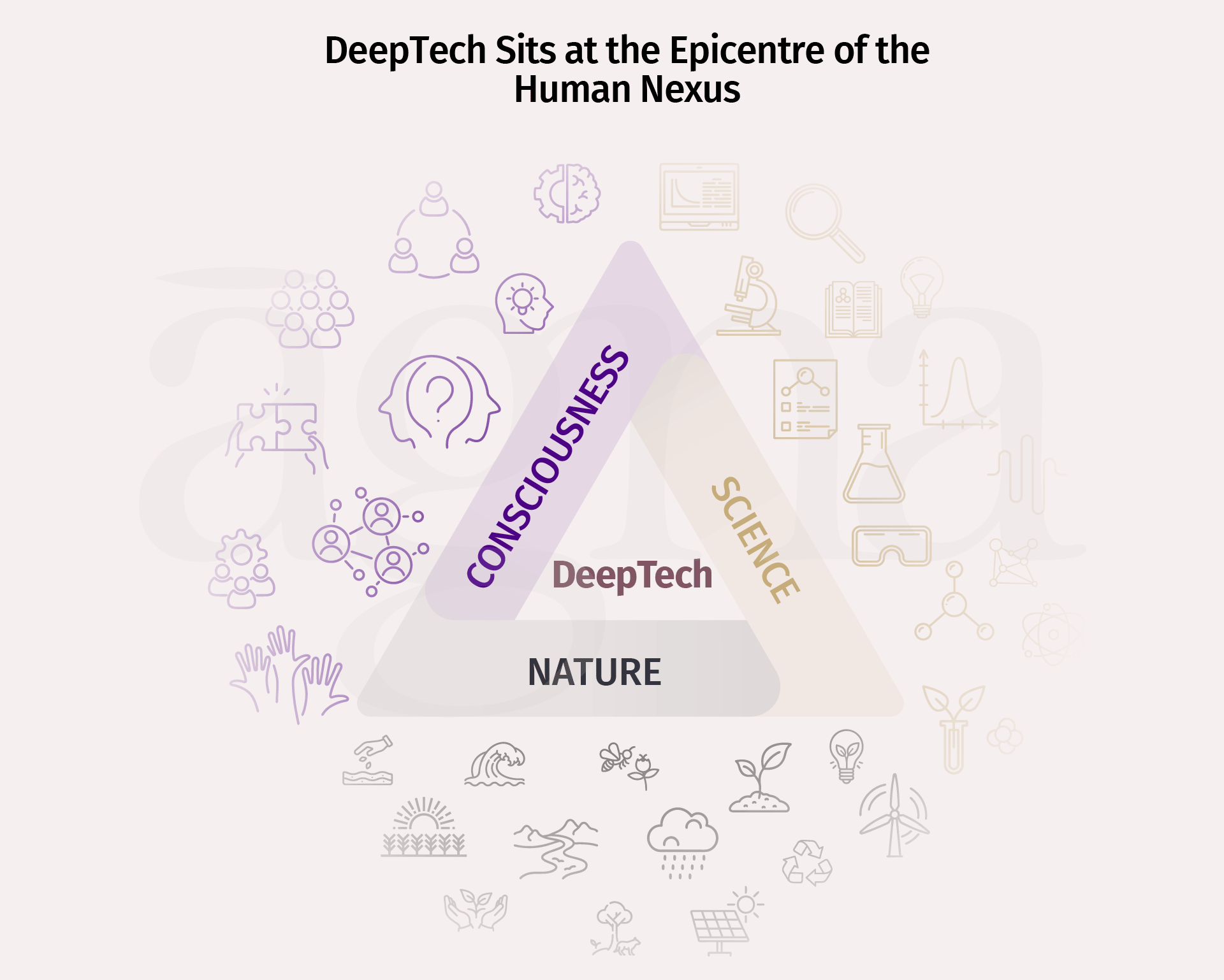
Living cells can now be engineered into programmable factories. Processors emulate brain-like networks for rapid and efficient computation. Materials are designed to respond to their environments, whether by blocking heat, harvesting energy, or changing form in response to new conditions. At the frontiers, some scientists are even investigating whether quantum effects at the subatomic level may play a role in perception, memory, and decision-making. While still a debated and emerging area of research, it reflects a broader shift: the effort to model both mind and matter in ways that make them explorable, replicable, and ultimately optimisable through engineering.
The progression has been gradual, but its impact has been profound. We began by working around nature. Then we learned to work upon it. Now, we are learning to work with it, embedding intelligence into environments that adapt and evolve in tandem with us. DeepTech is the foundation through which we will build, nurture, defend, and sustain our societies in the decades ahead.
Yet this architecture carries with it a profound responsibility. As a species, we have always aspired to improve—working with nature, building machines that grow more autonomous and human-like each day, and connecting increasingly complex systems through frontier technologies in our pursuit of civilisational progress. But aspiration must be paired with restraint. We must remain vigilant in recognising the boundary between empowerment and surrender.
The systems we are building today can operate continuously, make decisions without explanation, and act without human approval. Their capabilities are accelerating faster than our institutions can respond, raising the risk that the future of the Nexus may be shaped more by machine logic than by human intent.
This is why accountability, transparency, and explainability can no longer remain optional. These principles are the essential guardrails. They will determine whether DeepTech strengthens harmony among the forces of the Nexus or deepens the risks of fragmentation and instability. As we approach the threshold of Artificial General Intelligence, and eventually the possibility of Artificial Superintelligence, these safeguards must be viewed not only as ethical necessities, but as existential ones.
DeepTech offers a bridge. It connects nature’s complexity, human imagination, and machine capability. Whether that bridge leads to shared progress or unintended disruption will depend entirely on how we choose to build.
IV. From Nexus to Layers
Having explored numerous topics within DeepTech in our previous editions of #TheAgnaMuseletter, social media posts, and Theses (currently shared only with our investor community), we now set out to convey our conviction from a new angle.
In this edition, we envision a future where individuals interact with nature and technology across multiple fronts, where Frontier Technologies redefine how we live and solve civilisational challenges.
To frame this future, we see DeepTech operating across five interdependent layers: Biological, Environmental, Sovereignty, Cognitive, and Civilisational. Each builds on the other, compressing timelines and expanding capabilities, from programming life itself to engineering adaptive planetary systems, extending cognition, and ultimately reimagining the very settlements we inhabit.These layers are not abstractions; they are already emerging at the frontiers of science and industry today. What follows is both a survey of emerging capabilities and a projection of their societal impact, paired with storyboards of “a day in our new reality” that illustrate how these shifts may shape everyday life.
1. The Biological Layer
Biology is no longer a discipline of passive observation; it is becoming programmable. Health is shifting from a reactive model of treatment to a design-led model of resilience, where genomes and algorithms directly collaborate.
CRISPR gene editing, AI-designed enzymes, and biofoundries are compressing biological timelines from evolutionary scales into computational cycles. Ginkgo Bioworks programs cells like software platforms, Recursion Pharmaceuticals screens billions of cellular interactions with AI, and Moderna’s mRNA platform demonstrates how quickly biology can be retooled, pivoting from pandemic vaccines to oncology in just a few years. What once took a decade can now unfold in months.
The impact extends well beyond medicine. CRISPR-edited crops are being designed to withstand drought and heat, addressing food security in a warming world. Precision fermentation and synthetic proteins are reshaping the global food supply, while Ecovative’s mycelium materials are replacing plastics and leather with biodegradable alternatives. Here, biology is as much a material science and climate solution as it is a medical frontier.At the cutting edge, biology and computation are converging. DNA-based storage projects by Catalog and Microsoft suggest the genome itself could become a medium for archiving digital information at massive density. Biology is not just the study of life — it is becoming the substrate for health, food, climate resilience, materials, and even information systems.
The Biological Layer:
Reprogramming Life Itself
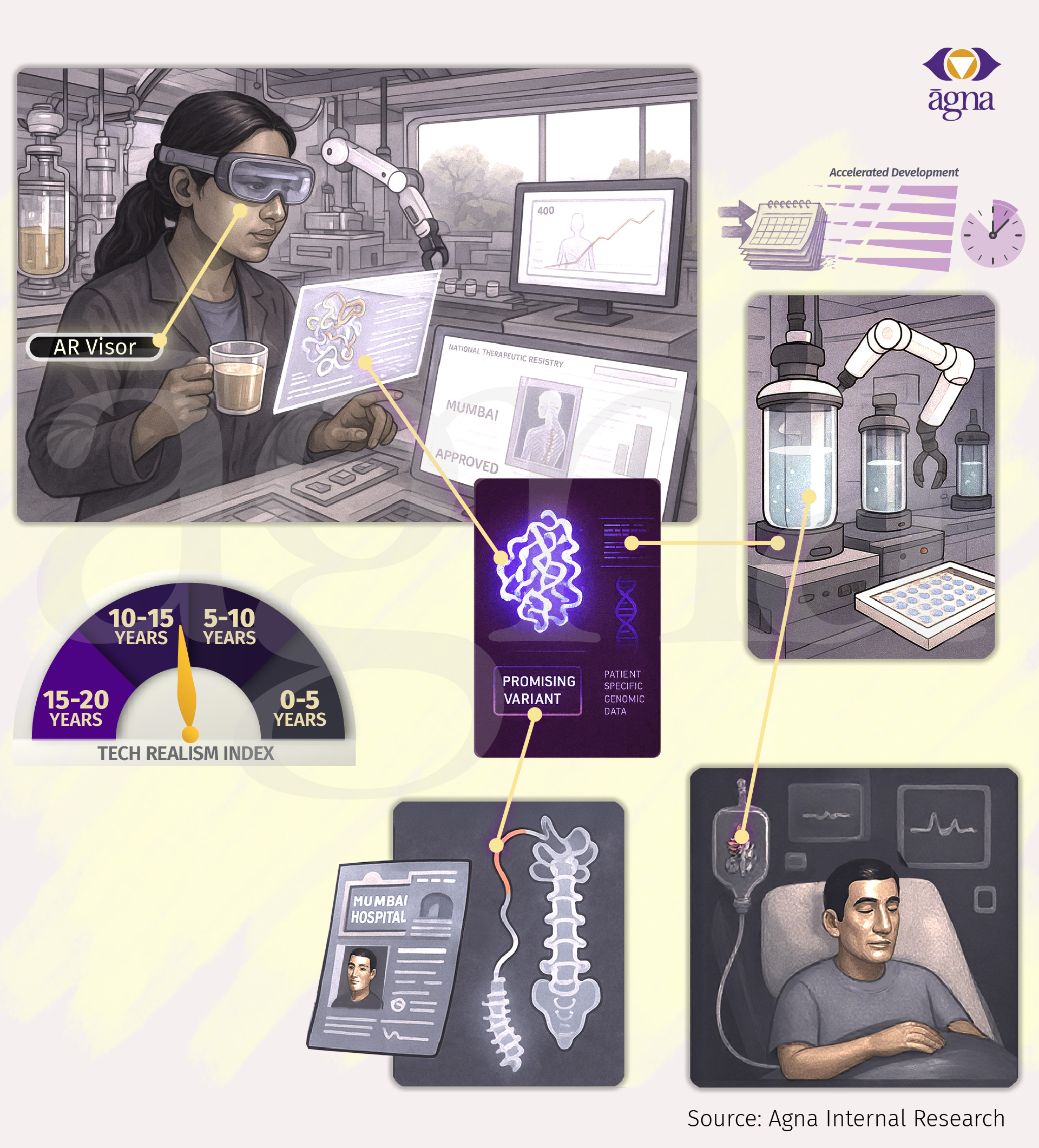
A day in our new reality: Priya
Priya starts her morning in a biofoundry on the outskirts of Bangalore, sipping chai as she checks the overnight progress on her AI-assisted enzyme design project. Her lab’s CRISPR workflows, run in fully automated bioreactors, have already processed 400 genome edits while she slept.
Today’s alert is a promising enzyme variant in her regenerative medicine program. Priya slips on her AR visor, reviewing 3D protein fold models alongside patient specific genomic data. A case from Mumbai with a severe spinal injury matches the enzyme’s profile for targeted tissue regeneration. She approves it for preclinical synthesis, which the lab’s robotic arms will complete before lunch.
By evening, the results are in. The enzyme shows exceptional cell adhesion rates. Priya forwards it to the national therapeutic registry, knowing that in a year, maybe even months, the therapy could be in hospitals, collapsing the once decade long drug cycle into a matter of computational sprints.
2. The Environmental Layer
For centuries, infrastructure has been static — built to endure but not to adapt. DeepTech is reversing this assumption, making the built environment responsive, regenerative, and intelligent. The planet itself is being rewired to act less like inert concrete and steel and more like a living system.
This shift is most urgent in the fight against climate change. Climeworks, the Swiss carbon removal company, already extracts 4,000 tonnes of CO₂ annually and is targeting 1 million tonnes by 2030. Energy Vault is testing gravity-based energy storage towers, and fusion ventures like Helion Energy and Commonwealth Fusion Systems promise virtually limitless clean power.
Cities are beginning to sense and adapt. Barcelona’s smart roads generate electricity from the pressure of vehicles. Japan’s Shinkansen rail system uses AI sensors to detect microscopic structural faults before they cause accidents. Buildings themselves are evolving into active systems: self-healing concrete repairs its own cracks, while bio-reactive facades lined with moss clean air and regulate temperature.
Water systems are also being reimagined. Aeronero’s atmospheric water generators extract drinking water from air, and next-generation desalination projects run on renewable energy, providing abundant, affordable fresh water. Scarcity is being displaced by infrastructure that manufactures resilience.At the frontier, distributed grids, hydrogen systems, and climate-adaptive design are converging. The result is planetary-scale infrastructure that breathes, senses, and heals; cities that grow resilient not by resisting change, but by adapting in real time.
The Environmental Layer:
Adaptive Planetary Systems
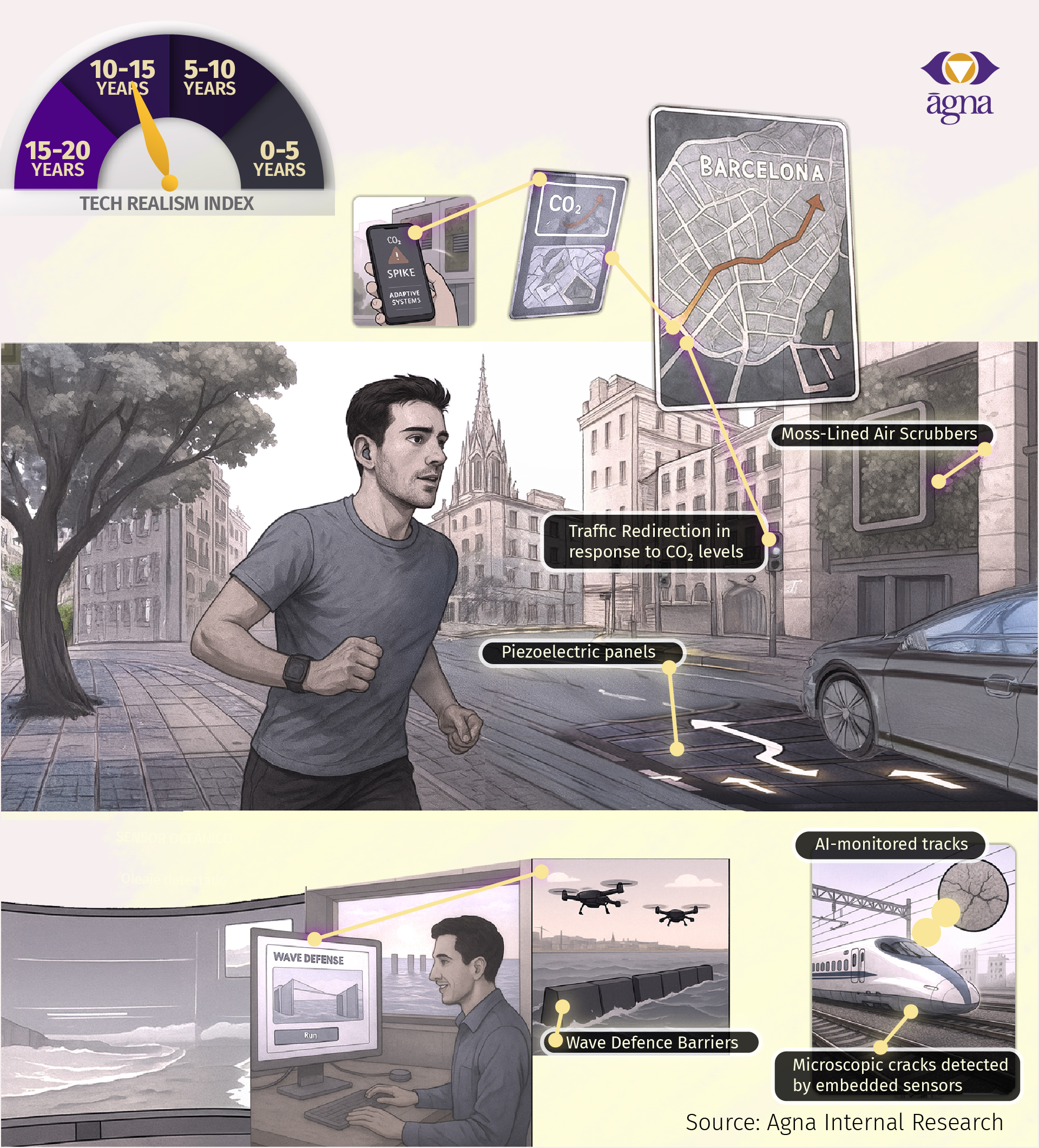
A day in our new reality: Mateo
Mateo wakes up in Barcelona to a city that’s always listening and breathing. His morning run takes him over piezoelectric roads that hum softly under passing trams, feeding stored energy into the neighborhood grid.
Halfway through his run, his climate app buzzes as CO₂ levels in the Gothic Quarter have spiked. The city’s adaptive systems instantly redirect traffic and activate moss lined air scrubbers embedded in building facades. By the time Mateo finishes his loop, the air feels crisper.
At his job in a coastal resilience lab, Mateo monitors ocean sensors detecting a swell that could damage the marina. An AI model recommends deploying smart barriers, which adjust in real time to wave force. As drones position the barriers, Mateo smiles. Barcelona doesn’t just respond to the planet anymore. It converses with it.
3. The Cognitive Layer
Human cognition is no longer bound to the skull. Advances in neuroscience, AI, and interface design are blurring the line between thought and computation, making the brain interoperable.
Early breakthroughs such as Neuralink and Synchron have enabled rudimentary brain–computer interfaces (BCIs), restoring basic control and communication to patients. At the same time, cognitive AI systems like Corti are already outperforming humans in detecting cardiac arrests during emergency calls, showing how reasoning itself is becoming autonomous.
The implications ripple far beyond healthcare. In education and work, AI copilots like Codex and Microsoft Copilot are becoming collaborative partners in creation and reasoning. In defence, DARPA’s Augmented Cognition programs are synchronising human decision-making with AI combat simulations, merging intuition with computational foresight.
The next step is cognitive co-agency: humans and machines making decisions together in continuous loops. Research into swarm cognition suggests that networks of humans and AI agents may form distributed intelligences — collective minds where agency is shared across species and substrates.The human mind, once solitary, is becoming a node in a larger cognitive network — extending, amplifying, and at times even displacing its own agency.
The Cognitive Layer:
Interoperable Minds
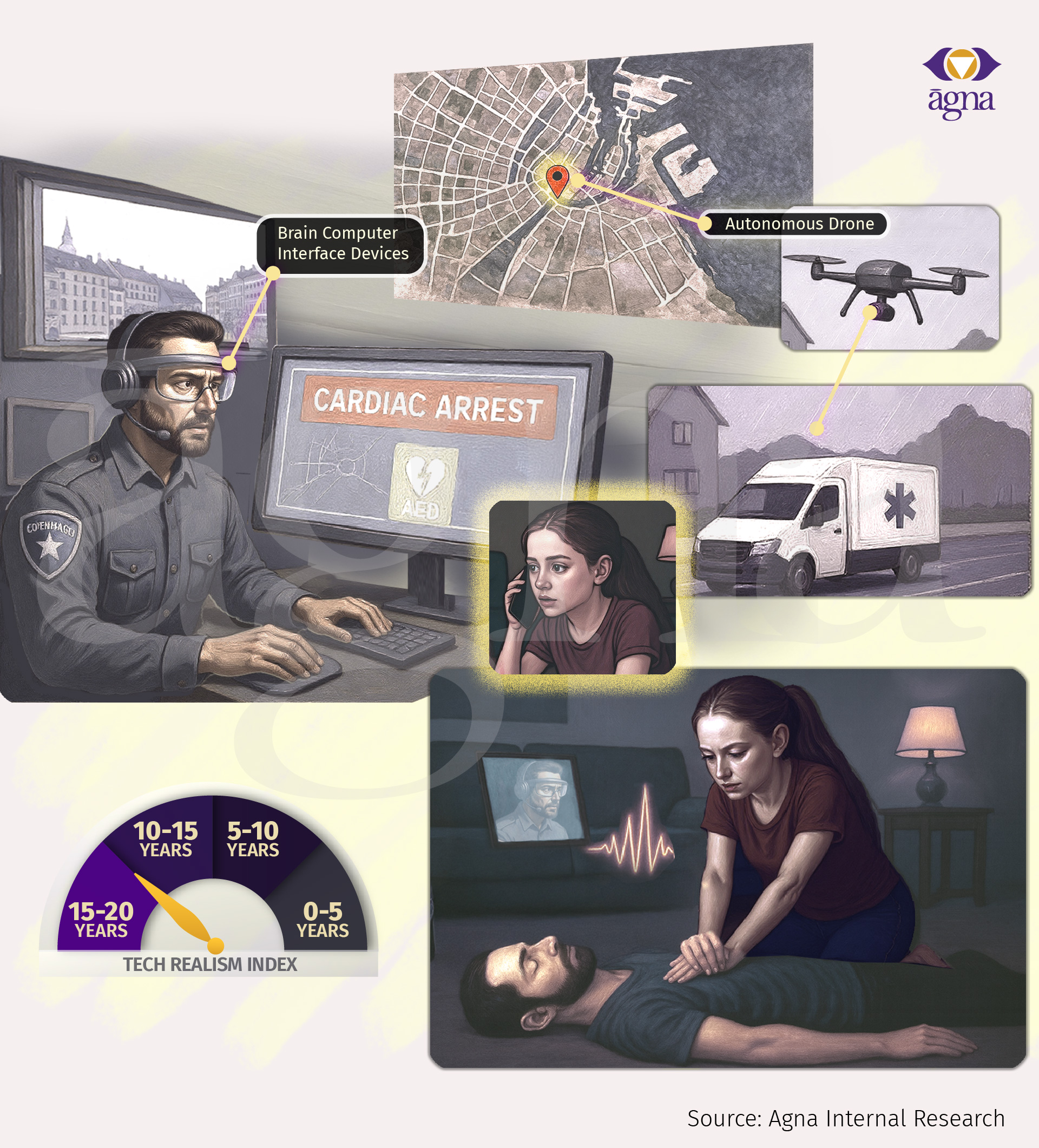
A day in our new reality: Omar
Omar is an emergency dispatcher in Copenhagen. As he fields a call from a panicked teenager about her father’s collapse, his neural co-pilot “Corti” is already parsing the voice patterns and background noise. Before Omar finishes his second question, Corti flashes a cardiac arrest alert on his visor.
Simultaneously, Omar’s BCI interface begins pulling the nearest AED location into the caller’s AR glasses and dispatching an ambulance. He guides her through compressions, while Corti’s synthetic voice corrects her rhythm in real time.
Minutes later, paramedics arrive, guided by an autonomous drone’s visual feed into Omar’s mind link. The patient survives. Omar removes the BCI at the end of his shift, reflecting on a world where cognition is no longer bound by a single brain.
4. The Sovereignty Layer
Governance, once defined by territory, borders, and bureaucracy, is being reshaped by computing power and simulation capacity. Sovereignty is shifting from maps to models.
This means cities and nations are now beginning to govern through digital twins and predictive platforms. Estonia’s X-Road integrates live data across government services, while Virtual Singapore uses a city-scale twin to stress-test urban planning and climate resilience. During the COVID-19 pandemic, Singapore relied on predictive models to anticipate hospital demand and mobility flows, compressing response times and improving resilience. Decision loops that once stretched across months are now compressed to milliseconds.
But this transformation is not only administrative; it is geopolitical. Computational sovereignty spans all domains: land, where logistics and agriculture are rerouted in real time; sea, where global port flows and undersea cables are mapped for resilience; air, where drones manage urban skies and airspace; and space, where satellite constellations are monitored through orbital twins.
Identity platforms such as India’s Aadhaar and emerging CBDCs show that finance and citizenship are being absorbed into computational architectures. Defence and security are fusing with algorithmic decision-making, as seen in Palantir’s platforms, NATO’s DIANA initiative, and DARPA’s augmented intelligence projects.
In the coming decade, sovereignty will be measured not only by borders but by a state’s ability to model, simulate, and act in real time.
The Sovereignty Layer:
Computational Governance
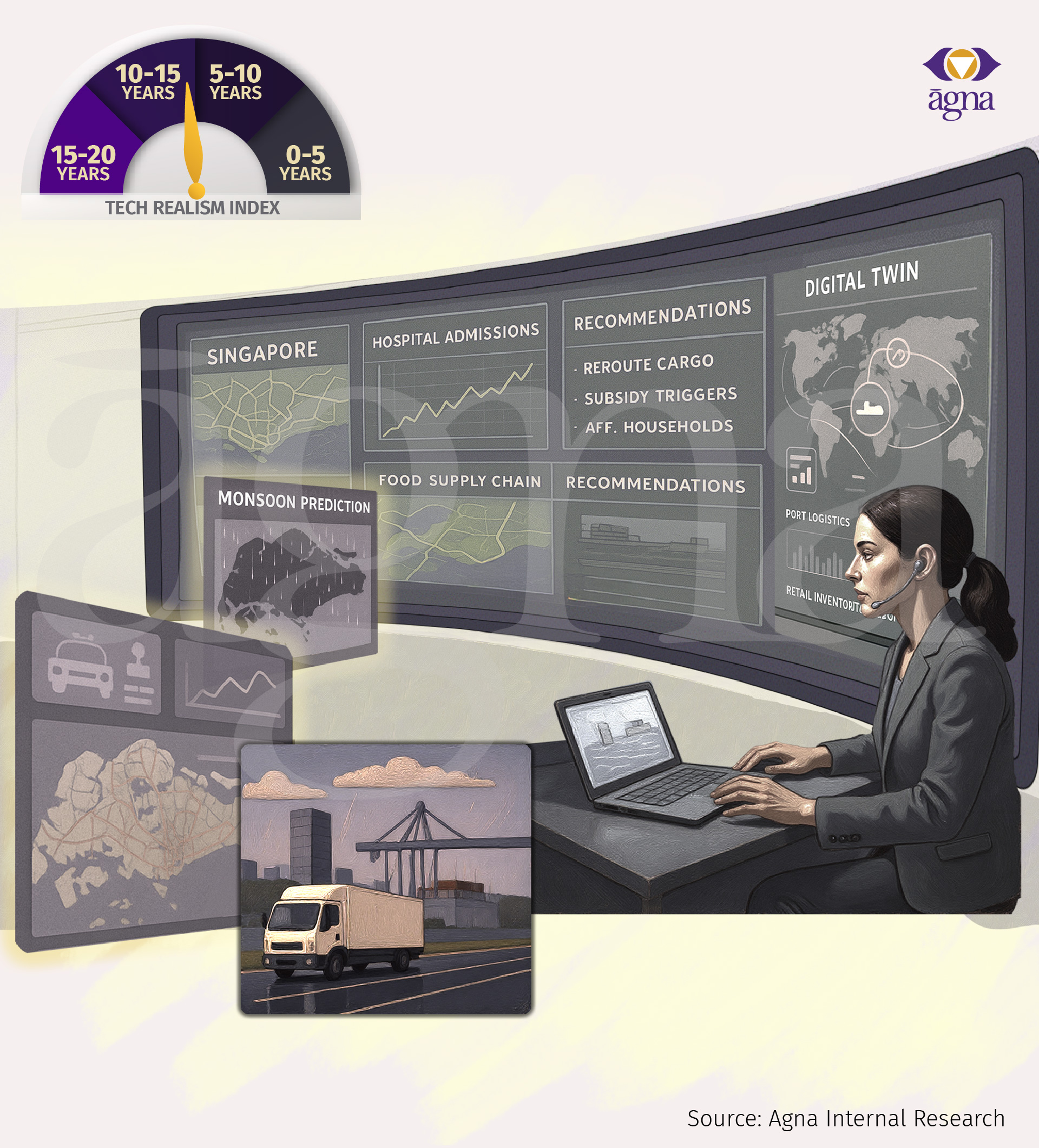
A day in our new reality: Leila
Leila begins her shift in Singapore’s National Operations Hub with a wall of living data—traffic flows, hospital admissions, power usage—updating in millisecond intervals. Today’s task is to model the impact of a sudden monsoon on the city’s food supply chains.
She runs a scenario through the nation’s digital twin, layering in global weather models, port logistics, and retail inventory. Within seconds, the system recommends optimal cargo reroutes and subsidy triggers for affected households.
Before this infrastructure existed, such planning would have taken months. Now, by lunch, the government has issued advisories, ports have reprioritised shipments, and autonomous trucks are already delivering to vulnerable areas. Leila logs off knowing governance has shifted from reactive bureaucracy to predictive choreography.
5. The Civilisational Layer
At the apex lies civilisation itself: the question of where and how humanity lives. For millennia, settlement was bound to geography, climate, and resource flows. DeepTech is breaking these constraints, allowing human habitats to become programmable systems.
On Earth, Oceanix Busan’s floating city is pioneering modular resilience to rising seas. ICON’s 3D-printed homes demonstrate how autonomous construction can provide rapid, affordable housing at scale. The EU’s New Bauhaus mission is embedding bio-integrated design into future settlements, making them regenerative rather than extractive.
In space, NASA’s Artemis program and projects like AI4Mars are simulating Martian civil infrastructure long before human arrival. NASA’s VIPER rover and ISRO’s Gaganyaan mission test systems were trained entirely in synthetic environments, learning to operate independently of Earth. Meanwhile, companies like Astroscale and LeoLabs are safeguarding orbital infrastructure by managing debris and monitoring satellite constellations.
Programmable settlement also implies synthetic ecologies: closed-loop systems in which food, water, and energy recycle indefinitely, sustaining life in alien or extreme conditions. These ecosystems may precede humans, maintained by AI agents and robotic systems until settlers arrive.
The ultimate impact is civilisational. Settlements will no longer be bound to rivers, fertile plains, or stable climates, but will be designed, simulated, and deployed anywhere, from floating platforms on Earth to lunar craters and Martian valleys. In this sense, settlement itself becomes programmable.
The Civilisational Layer:
Programmable Settlement
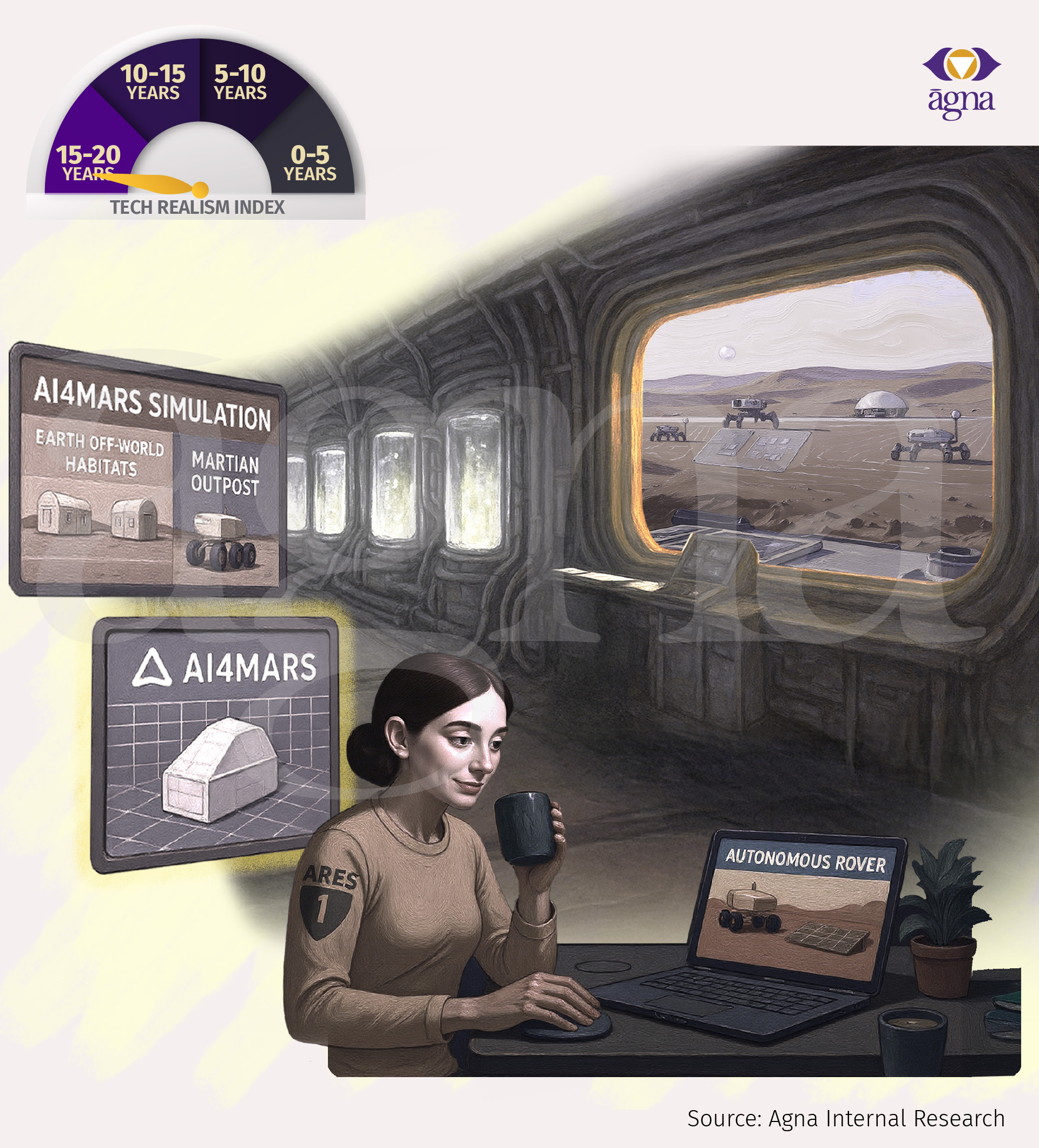
A day in our new reality: Aya
Aya wakes not to sunrise, but to the programmed glow of an artificial dawn on Ares 1, a Martian research habitat. Her morning coffee is brewed from algae based beans, grown in bioreactors lining the habitat walls.
Before her shift, she checks the AI4Mars simulation that coordinates life support across Earth’s off world settlements. Today’s updates include habitat module designs for a new Martian outpost, tested entirely in virtual environments before a single atom is launched.
Her task is to train the settlement’s autonomous rover team to deploy solar arrays without human guidance. By evening, the rovers complete the setup flawlessly. Aya logs her work into the shared interplanetary ledger, knowing these steps bring humanity closer to living and thriving on Mars.
The Living Model of a Nation: The DeepTech Convergence
This case study imagines INDUS (Integrated National Defence Unified System), a conceptual future architecture for India’s national security (or any nation for that matter). Conceived as the natural evolution of current platforms like IMAC, NATGRID, Akashteer, and India’s Defence Cyber and Space agencies, INDUS is a real-time, computationally unified national security system, built to simulate, detect, and respond to multi-domain threats across land, sea, air, space, and cyber.
The Living Model of a Nation
When DeepTech Layers Converge to Defend Sovereignty in Real Time
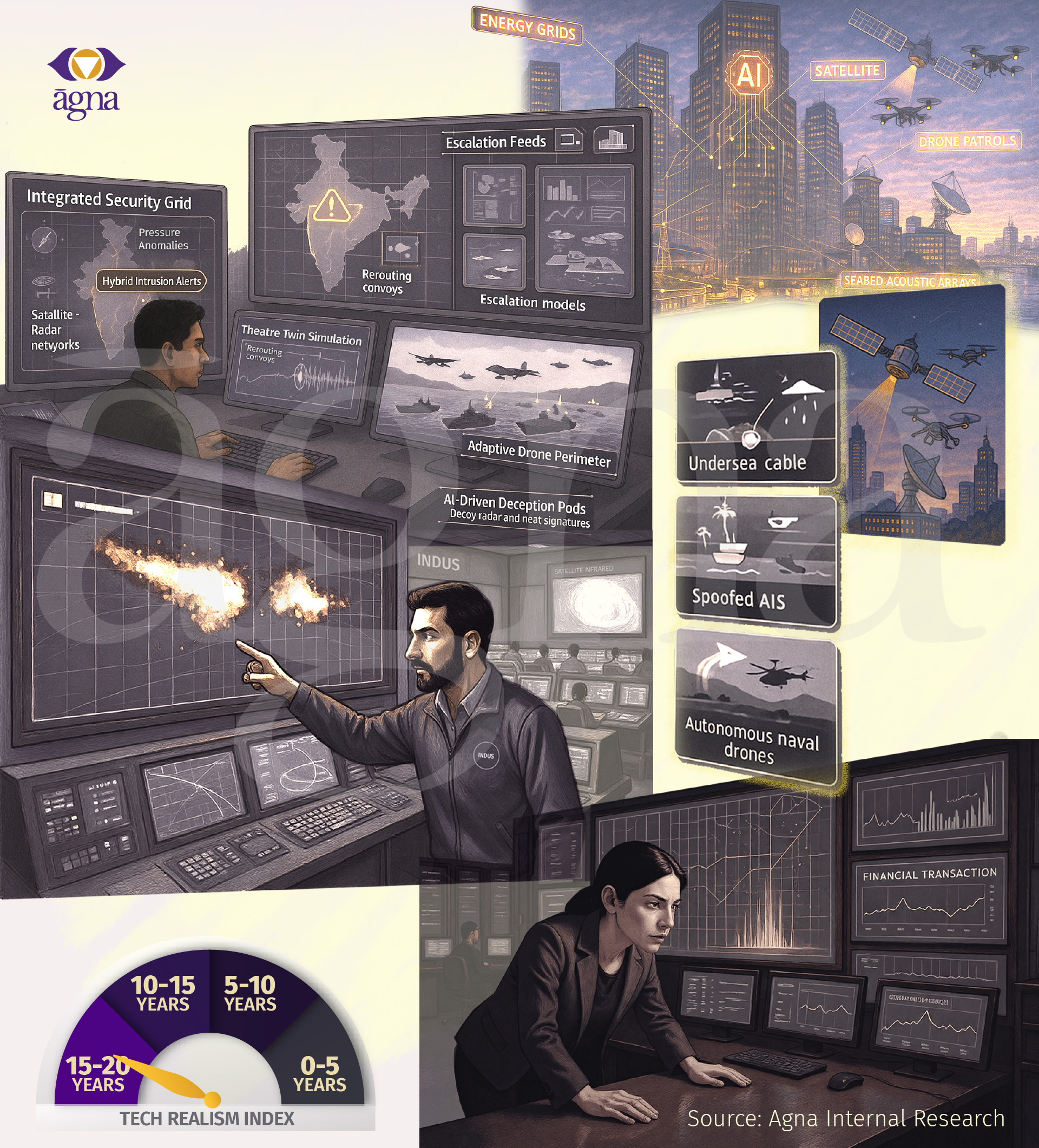
Story: A Day in Our New Reality — Arjun, Meera, and Kabir
Inside India’s INDUS (the Integrated National Defence Unified System), envisioned as the natural evolution of IMAC, NATGRID, Akashteer, and the Defence Cyber & Space Agencies — also known as SurakshaNetra (the nation’s Security Eye), a vast wall of fused feeds runs live. Satellites sweep orbital paths, seabed acoustic arrays hum with ocean data, drone patrols trace the skies, radar networks sweep borders, while energy grids and financial transaction flows pulse in millisecond rhythms. In this command centre, specialists sit shoulder to shoulder, each responsible for a domain, all linked through the same living model of the nation.
At 03:07, anomalies surface. Arjun, a former naval officer at the maritime desk, watches pressure shifts on an undersea cable in the Bay of Bengal while AIS signals from merchant ships fail to match orbital imagery. The bio-acoustic grid, tuned to whale calls and marine patterns, detects disturbances suggesting unmanned submersibles moving silently beneath the waves. Across the room, Kabir, an aerospace engineer at the orbital desk, tracks unusual heat signatures clustering in a high-altitude corridor, cross-checking them with satellite infrared feeds and orbital twin simulations. At the cyber desk, Meera, an analyst of grids and financial systems, notices sudden bursts in transaction flows coupled with subtle load instabilities, digital noise pointing to a coordinated probe of critical infrastructure.
The AI fuses their perspectives into one storyline: a grey-zone intrusion spanning sea, air, space, and cyber. Escalation models ripple through the theatre twin, generating counter-moves. Convoys are rerouted along predictive logistics corridors while autonomous naval drones redeploy from the Andaman theatre. Communications shift to quantum-encrypted channels, even as cyber telemetry overlays forecast banking diversions and deploy defensive patches.
Infrastructure adapts as if alive. Grids rebalance, ports reschedule cargo flows, and banking networks harden in anticipation of cyber strikes. Overhead, electronic warfare pods prepare to saturate the high-altitude corridor while digital deception pods throw out phantom radar and heat signatures, forcing adversaries to chase ghosts. Drone swarms tighten into an adaptive aerial perimeter as satellites tilt for sharper coverage.
The three confer quickly, validate the AI’s recommendations, and escalate to the command lead. Authorisation is granted. Within minutes, the system responds in concert—sea lanes secured, airspace shielded, cyberspace stabilised. By dawn, the probe is contained — without a shot fired.In this reality, sovereignty is not reaction but computation: a collective model spanning land, sea, air, space, and cyber, simulating millions of futures and executing the one that preserves stability in real time.
At its core, INDUS embodies the convergence of all five DeepTech layers, not just as standalone capabilities, but as a fused, living model of sovereign resilience and decision-making.
- The Biological Layer powers marine surveillance through bio-acoustic sensor arrays, tuned to marine mammal patterns and seabed vibrations, offering real-time anomaly detection.
- The Environmental Layer manifests through responsive infrastructure: grids rebalancing automatically, ports adapting cargo flows, and electromagnetic warfare pods reacting to atmospheric changes.
- The Cognitive Layer synchronises human-AI decision-making through scenario engines, real-time narrative fusion, and threat trajectory simulation.
- The Sovereignty Layer is expressed in full through quantum-encrypted communications, digital twins of all defence domains, AI-enabled command-and-control, drone swarms, predictive logistics, and autonomous deterrence systems.
- The Civilisational Layer underpins the whole system; a model of programmable sovereignty designed to secure peace, deter conflict, and stabilise the nation without kinetic escalation.
This is not a single-point system. It is a multi-domain, proactive intelligence and response architecture that fuses sensing, simulation, decision, and action into an integrated digital twin of the nation-state.
Signals of a Converging Reality
Across the world, signs of this DeepTech convergence are already visible: - In the maritime domain, platforms like DARPA’s Sea Hunter and India’s IN-MAC are enabling persistent unmanned surveillance across surface and sub-surface waters, fusing data from seabed acoustic sensors, coastal radar, and aerial ISR systems.
- In space, initiatives such as DARPA’s Blackjack and the ESA’s Space Situational Awareness (SSA) program are building orbital twins to simulate satellite health, trajectory, and debris management. Startups like LeoLabs, Kayhan Space, and Privateer offer space domain awareness-as-a-service, enabling real-time tracking of orbital infrastructure and anomalies.
- The U.S. Space Force (USSF) anchors orbital sovereignty through strategic platforms like the Unified Data Library (UDL) and Space Fence, a high-precision radar system for tracking orbital debris and adversarial assets. Its integration with JADC2 and NORAD reflects a paradigm shift — where space is treated as a sovereign warfighting domain, not merely a support layer.
- In the air domain, integrated AI platforms such as Israel’s Fire Weaver, the Skyborg autonomy core system, and HBTSS (Hypersonic and Ballistic Tracking Space Sensor) architectures are compressing detection-to-response cycles. These enable autonomous interception, real-time target fusion, and layered aerial defence through swarms and AI-guided countermeasures.
- On land, NATO’s Federated Mission Networks and LVC (Live-Virtual-Constructive) environments simulate real-time strategy against synthetic adversaries. AI-first defence startups like Shield AI, Anduril Industries, and Palantir are already supporting edge computing, autonomous battlefield mapping, and multi-domain mission planning.
- In cyber and computing, nations are investing heavily in sovereign cloud infrastructure, quantum-resistant encryption standards, and AI-powered C4ISR engines to secure decision-making dominance, cross-domain coordination, and resilient communication grids.
Together, these developments signal a global transition from territorial defence to computational sovereignty. Every advancement, whether in AI fusion, orbital tracking, or synthetic environments, is a signal that the INDUS model is not mere fiction, but a converging reality.
While the full-scale convergence described in the INDUS vision may take time to mature, the foundational technologies and institutional shifts are already underway. The challenge is not capability, but coordination across systems, protocols, and governance.
The trajectory is unmistakable. Sovereignty is being redefined not just by territory, but by a nation’s ability to sense, simulate, and act faster than emerging threats. In the coming decade, maps will matter less than models. Power will flow not just from troops or treaties, but from chips, code, and computation.The Living Model of a Nation is no longer a metaphor. It is a DeepTech convergence that is already beginning to take shape.
V. Conclusion
Nature, humans, and machines now form a triangular system. Each operates with its own autonomy, yet all remain interlinked. DeepTech is the architecture holding this system together. It connects biology, matter, and cognition into programmable layers of influence.
The risk is speed. Systems already act faster than humans or institutions can respond. They run continuously, make opaque decisions, and interact machine-to-machine beyond human oversight.
The safeguard is governance. Accountability, transparency, and explainability are not optional; they are structural requirements. Without them, the balance of the Nexus will tilt toward machine logic. With them, DeepTech can align natural complexity, human imagination, and computational capability to drive civilisational progress.
Listen to this Museletter
Questions? Feedback? Different perspective?
We invite you to engage with us and collaborate.
Warm Regards,
Team Agna
Click below to join our mailing list for The Agna Museletter.
Agna Capital Limited is regulated by the Dubai Financial Services Authority
